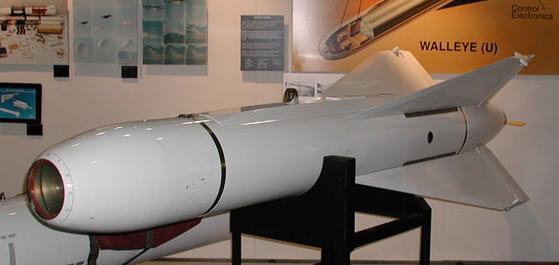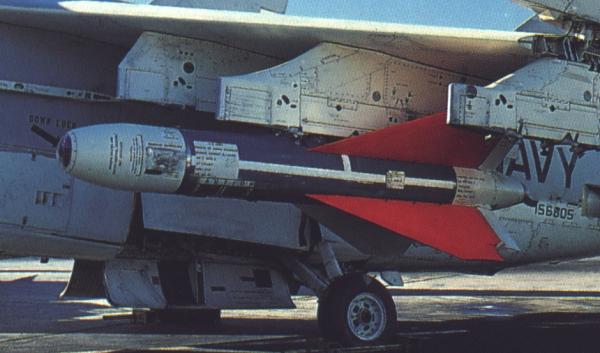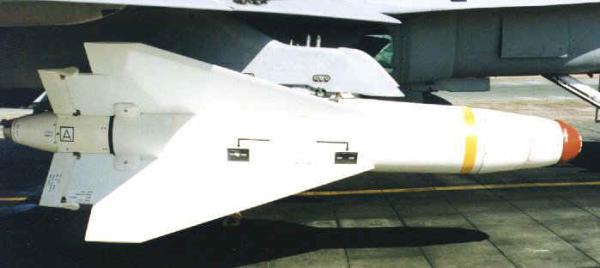Martin Marietta AGM-62 Walleye
The Walleye was an unpowered TV-guided glide bomb of the U.S. Navy, which was temporarily designated as a guided missile and is therefore included in this missile directory.
In 1963, the Naval Ordnance Test Station (NOTS, later Naval Weapons Center NWC) at China Lake began the development of an unpowered television-guided glide bomb, to be named Walleye. Although it had no propulsion system, it was designated as AGM-62A in the newly created missile and rocket designation system. AGM-62 was actually the first new designation allocated in this series, as all lower numbers were used up for redesignations of existing missiles. Walleye was to provide the pilots of strike aircraft with a fire-and-forget high-precision air-to-ground weapon, i.e. the aircraft should be able to turn away as soon as the weapon was launched. The only guided tactical air-to-ground missile available at the time, the AGM-12 Bullpup, required the pilot of the attacking aircraft to manually guide the missile all the way to the target. After an industry-wide competition for a missile design for the NOTS TV-guidance system in 1964/65, Martin received a production contract for Walleye in January 1966. In 1967, Walleye entered service with the U.S. Navy. In that year the USAF also ordered its first batch of Walleyes, but Air Force use of this weapon was very limited.
 |
| Photo: Bill Spidle |
| Walleye I MK 1 MOD 0 (AGM-62A) |
The Walleye was a glide bomb controlled by four large wings with trailing-edge control surfaces. In the nose it had a TV camera, which transmitted its image to a screen in the launching aircraft. When the pilot had acquired a target on this image, he "locked" the image and released the weapon. The guidance system then continually matched the current TV image with the locked one, and corrected the course of the missile to compensate any deviations. Power for the TV and other systems was provided by a ram-air turbine driven by a small propeller in the missile's tail. The TV-guidance system proved to be quite successful when used against targets which stood out clearly against the background, but capability to remain locked on low-contrast targets was decidedly unsatisfactory. The relatively light-weight 374 kg (825 lb) MK 58 linear shaped-charge warhead also meant, that only a direct hit was really effective. The maximum range of the glide bomb depended of course heavily on launch altitude, but minimum range for all Walleye versions is generally given as 1.8 km (1 nm).
 |
| Photo: U.S. Navy via Home of M.A.T.S. |
| Walleye I MK 1 |
By the time the production contract was awarded in 1966, the Navy had second thoughts about designating an unpowered glide weapon in the guided missile series, and dropped the AGM-62 designator. Instead, the initial production Walleye was known as Guided Weapon, MK 1 MOD 0. Later Walleye variants received higher MARK and MOD numbers. The Walleye MK 2 was an inert training variant of the tactical weapon. The MK 3 Walleye ER (Extended Range) was a version with slightly larger wings for extended glide range, and MK 4 was another training missile (possibly of ER configuration). To evaluate the results of captive-carry training flights, the MOD 1, 4, 6, and 7 versions of the MK 4 had a video-recorder to record the TV camera image for post-flight analysis.
 |
| Photo: U.S. Navy |
| Walleye I ER MK 3 MOD 0 |
The small warhead of the original Walleye was useless against many hardened or large high value targets, like bridges and powerplants. Therefore the NWC developed a significantly enlarged version, initially known as "Fat Albert", but officially designated Guided Weapon MK 5 Walleye II (the small-warhead versions were renamed Walleye I). The Walleye II had a larger body with a 900 kg (2000 lb) MK 87 linear shaped-charge warhead, and much larger fins for further extended glide range. The seeker of the MK 5 used a smaller optical "gate" for increased accuracy, but this required even better contrast for a successful lock-on. The Walleye II was built by Hughes under subcontract to Martin Marietta. After operational evaluation in 1973, it was introduced in U.S. Navy service in January 1974 in the MK 5 MOD 4 variant.
The designation MK 6 referred to a nuclear version of the Walleye II, armed with a low-yield (625 T) W-72 fission warhead. The W-72s were rebuilt low-yield W-54 warheads taken from retired weapons. Although the W-72 was stockpiled, it's possible that no Walleye missiles were ever completed as all-up nuclear rounds. The W-72 warhead was removed from the nuclear stockpile in 1979.
The next major step in the evolution of Walleye was the ERDL (Extended Range Data Link) modification. One drawback of the Walleye's guidance system was the requirement to lock the seeker onto the target before launch, meaning that the attack aircraft had to come relatively close to a potentially heavily defended target. The ERDL system equipped the Walleye with a two-way datalink, and the launch aircraft were equipped with an AN/AWW-9 (later AN/AWW-13) underwing data-link pod. The pilot could now launch the Walleye out of visual range of the target, turn away, watch the bomb's TV camera image, which was transmitted via the data-link, and lock-on to the target at any convenient moment. It was even possible to control the weapon from a different aircraft than that which launched the Walleye, and because of the limited number of data-link pods available, it was actually standard practice for one pod-equipped aircraft to guide Walleyes dropped by several attack aircraft (not simultaneously, though). To use the beyond-visual-range capability to full effect, ERDL Walleyes were usually dropped from high altitude which led to glide ranges of up to 60000 m (65000 yd) for the Walleye II. The Walleye II ERDL also had slightly larger wings than the standard Walleye II. The initial production variants in 1975 were the MK 21 Walleye I ERDL and MK 23 Walleye II ERDL. These versions used a MK 46 guidance section and a MK 159 control section. The MK 22 was a Walleye I ERDL variant, which replaced these components with MK 53 and MK 165 guidance and control sections, respectively. I haven't found any reference to a Walleye MK 24, but it seems plausible that this nomenclature was reserved for a Walleye II ERDL variant with the MK 22's components. Production of the ERDL Walleyes ended in 1976, but in the late 1970s, around 1400 Walleye Is and 2400 Walleye IIs were converted to ERDL variants. The Walleye ERDL Trainer MK 27 was an inert training missile for both ERDL variants (MODs 3,4,5 were of Walleye II configuration) and was used for ground handling and captive-carry flight training.
 |
| Photo: U.S. Navy |
| Walleye I ERDL MK 21 (with AN/AWW-9) |
In the 1980s, the data-link equipment was upgraded, leading to the interim Walleye ERDL Phase I and the final Walleye ERDL Phase II configurations. The Phase II configuration is also known as ERDL/DPSK (Digital Phase-Shift Keying). I don't know exact details of this upgrade, but it was most probably a reliability and anti-jamming improvement for the data-link. The initial ERDL Phase II models were the MK 29 Walleye I ERDL/DPSK and the MK 30 Walleye II ERDL/DPSK, respectively. These variants used MK 64 guidance and MK 187 control sections, while the later MK 34 and MK 37 Walleye I/II ERDL/DPSK models had MK 71 guidance sections instead. The MK 38 was a special ERDL/DPSK inert training model for use with data-link equipped F/A-18 Hornet aircraft.
 |
| Photo: via MILITARY.CZ |
| Walleye II ERDL (exact MARK/MOD unknown) |
There were many other MARKs and MODs of the Walleye glide-bomb, which differed by having different types and versions of components (warhead, warhead section, guidance section, control section) or simply used different frequencies for the data-link (which had to be pre-selected from multiple options for the original ERDL models). A typical example is the MK 29 series, which used all possible combinations of two guidance sections (MK 64 MOD 0 and MOD 1), five control sections (MK 187 MODs 0 through 4), and two sets of warhead sections (MK 98 MOD 0/2 and MOD 1/3), to create the initial 2x5x2=20 MODs of the MK 29 weapon. MK 29 MODs 20 and up used a different guidance section (MK 65 MOD 0/1).
I don't know the details of most of the MK/MOD variations, but the following two tables are provided to give a complete cross reference to all Walleye Guided Weapon MK/MOD designations known to me.
|
|
Gradual phase-out of the Walleye began in the late 1980s, but in Operation Desert Storm in 1991, it was again used in combat. After the war ended, the Navy quickly retired the A-7E Corsair, the main launch platform for Walleye, and the missile was subsequently removed from active service in the mid-1990s. A total of about 5000 Walleye glide bombs of all types were built by Martin Marietta and Hughes.
Specifications
Note: Data given by several sources show slight variations. Figures given below may therefore be inaccurate! Quotes range figures are maximum values for high-altitude launches.
Data for Walleye I MK 1 MOD 0 (AGM-62A) and Walleye II MK 5 MOD 4 (except where noted):
| Walleye I MK 1 MOD 0 | Walleye II MK 5 MOD 4 | |
|---|---|---|
| Length | 3.45 m (136 in) | 4.04 m (159 in) |
| Wingspan | 1.15 m (45.5 in) | 1.30 m (51 in) |
| Diameter | 0.318 m (12.5 in) | 0.457 m (18 in) |
| Weight | 510 kg (1125 lb) | 1060 kg (2340 lb) |
| Speed | high subsonic | |
| Range | 30 km (16 nm) | 45 km (24 nm) Walleye II ERDL MK 23 MOD 0: 60 km (32 nm) |
| Propulsion | none | |
| Warhead | 374 kg (825 lb) MK 58 linear shaped-charge | 900 kg (2000 lb) MK 87 linear shaped-charge MK 6 MOD 0: W-72 nuclear fission (625 T) |
Main Sources
[1] Norman Friedman: "US Naval Weapons", Conway Maritime Press, 1983
[2] Bill Gunston: "The Illustrated Encyclopedia of Rockets and Missiles", Salamander Books Ltd, 1979
[3] Christopher Chant: "World Encyclopaedia of Modern Air Weapons", Patrick Stephens Ltd., 1988
[4] R.T. Pretty, D.H.R. Archer (eds.): "Jane's Weapon Systems 1972-73", Jane's, 1973
Back to Current Designations Of U.S. Unmanned Military Aerospace Vehicles
Back to Directory of U.S. Military Rockets and Missiles
Last Updated: 16 September 2002